At 5 o’clock in the evening of 31st May 1533, Queen Anne Boleyn left the Tower of London and began her coronation procession to Westminster Hall.
Click the image to see a larger animation of the procession
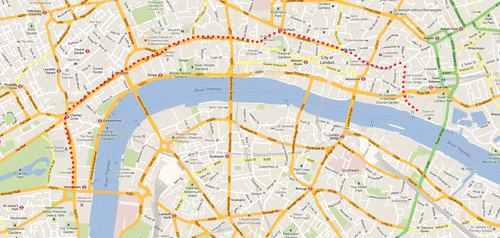
The Queen’s part of the procession was led by the servants of Jean de Dinteville, the French ambassador, who were dressed in blue velvet coats with sleeves of blue and yellow velvet. Their horses were “trapped with close trappers of blue sarcenet powdered with white crosses”. After them came “gentlemen, squires and knights”, followed by the judges, and the Knights of the Bath, dressed in ermine trimmed violet gowns and hoods. Next were abbots, barons, bishops, earls, marquesses, the Lord Chancellor, the Archbishop of York, the Venetian ambassador, the Archbishop of Canterbury, the French ambassador, the Mayor of London, William Howard (acting as deputy earl marshal for his brother, Thomas Howard, Duke of Norfolk) and Charles Brandon, Duke of Suffolk, acting as Constable of England.
Behind her chancellor, “sergeants and officers of arms”, came Queen Anne Boleyn in a litter decorated with white cloth of gold and led by two palfreys clad in white damask. Hall describes Anne as wearing a surcoat of white cloth of gold, a mantle of the same cloth, but trimmed with ermine, and a coif with a circlet of “rich stones”. Her hair was loose and flowing. Above her was a canopy of cloth of gold, decorated with gilt statues and silver bells, and carried by the barons of the Cinque Ports. Following the Queen were her chamberlain, Lord Borough, and her master of the horses, William Coffin, then her ladies clothed in crimson velvet and cloth of gold and tissue. Then came chariots carrying the Dowager Duchess of Norfolk and the Marchioness of Dorset (or possibly Elizabeth Boleyn, Anne’s mother), and other ladies of the court.
The route of the coronation procession included Fenchurch Street, Gracechurch Street (and Leadenhall), Cornhill Street, Poultry, Cheapside, St Paul’s Cathedral, St Paul’s Churchyard, Ludgate, Fleet Street, Temple Bar, and then probably the Strand, the present day Trafalgar Square, Whitehall and, finally, Westminster Hall. It wasn’t just a simple procession, it included various stops for pageants and entertainment, which we know about from chronicler Edward Hall and “The noble tryumphaunt coronacyon of quene Anne” pamphlet from 1533:
Fenchurch Street
“A pageaunt all with children apparelled like marchauntes whiche welcommed her to the Citiewith two proper preposicions both in Frenche & Englishe”.
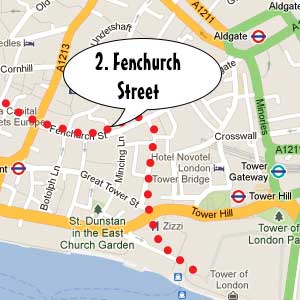
Gracechurch Street
“A ryght costly pagent of Apollo with the nyne muses amonge ye mountaynes syttyng on ye mount of Pernasus [Parnassus] and euery of them hauynge theyr instruments and apparayle acordyng to the descryption of poets and namely of Uirgyll[Virgil] with many goodly verses to her great prayse and honour.” There was also a wine fountain there.
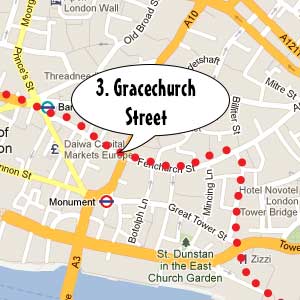
Leaden Hall, Gracechurch St
Here, there were two pageants. The first had Anne Boleyn’s falcon badge as its theme. It had a castle with a green, and a “root” (or stump) out of which white and red roses spilled. A white falcon descended from Heaven and landed on the stump, then an angel wearing armour descended and crowned the falcon. The second pageant consisted of St Anne, surrounded by her children, the three Marys, and their children. Here, verses were read to Queen Anne Boleyn, poetry which emphasised England’s hope for her and the child she was carrying.
The Conduit on Cornhill Street
Here, there “was a sumptuous pagent of the thre graces: and at the comynge of the quenes grace a poete declared the nature of all those thre ladyes and gave hye prayses vnto the quene. And after his preamble fynysshed every lady partyculer spake great honour and hye prayse of the quenes grace.” Hall adds that there was also “the spryng of grace continually ronnyng wyne.”
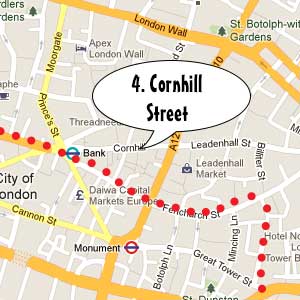
Cheapside
At the “great conduit”, which was newly painted with “arms and devices”, there was “a costly fountayne whereout ranne whyte wyne claret and red great plenty all that after noone: and ther was great melody with speches.”
At Cheapside Cross, which had been “newe garnisshed”, she met the Aldermen and the Recorder of London who “came to her with lone reuerence makyng a proper and briefe proposicion and gaue to her in the name of the Citie a thousand markes in golde in a Purse of golde, whiche she thankefully accepted with many goodly wordes.”
At the lesser conduit, there was a pageant of the Judgement of Paris: “And within that pagent was fyue costly seates wherin was set these fyue personages that is to wete Juno Pallas Mercury and Venus and Parys hauyng a ball of golde presentyng it to her grace with certayne verses of great honour and chyldren syngyng a balade to her grace and prayse to all her ladyes.”
Nasim Tadghighi explained in her article on the coronation procession that in this pageant “Paris of Troy is asked to judge who of three goddess – Juno, Pallas and Venus – should be rewarded with the golden apple, a prize which he granted to Venus. The renowned story is given a slight twist here. When Anne approached the display Paris was just about to give the apple to Venus but upon seeing Anne he grants her the prize, for her exceeding beauty and grace.”
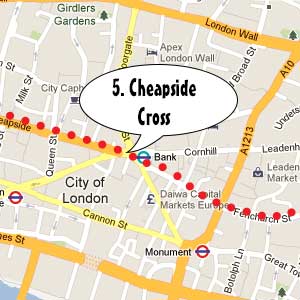
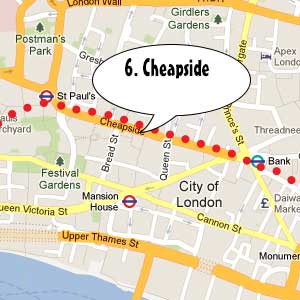
St Paul’s Cathedral
Here, there was “a proper and a sumptuous pagent yt is to wete ther sat. iij. fayre ladyes virgyns costly arayde with a fayre rounde trone ouer their heedes where aboute was written this. Regina Anna prospere precede et regna that is in englysshe Quene Anne prospere precede and reygne. The lady that sate in the myddes hauynge a table of golde in her hande wrytten with letters of asure. Ueni amica coronaberis. Come my loue thou shall be crowned. And two aungels hauyng a close crowne of golde bytwene
their handes. And the lady on ye ryght hande had a table of syluer wherein was writte. Domine dirige gressos meos. Lorde god dyrecte my wayes. The other on the lyfte hande had in another table of syluer written thus. Confide in domino. Trust in god. And vnder theyr fete was a longe rol wherin was written this. Regina Anna nouum regis de sanguine natum cum paries populis aurea secla tuis. Quene Anne whan yu shalte beare a newe sone of ye kynges bloode there shalbe a golden worlde vnto thy people.”
The ladies then threw wafers and rose leaves, and on the wafers were verses written in gold.
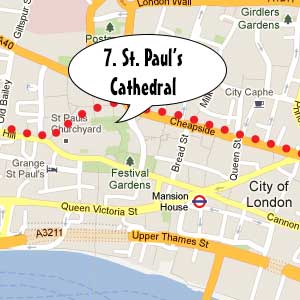
St Paul’s Churchyard
On a scaffold here, Hall records that two hundred “well apparelled” schoolchildren said to the Queen “diuers goodly verses of Poetes translated into Englishe, to the honor of the kyng and her.”
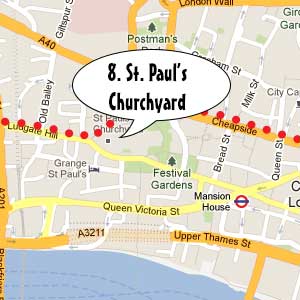
St Martin’s Church at Ludgate
Hall describes how a choir of men and children stood on the leads of the church roof and sang “newe balades made in praise of her.”
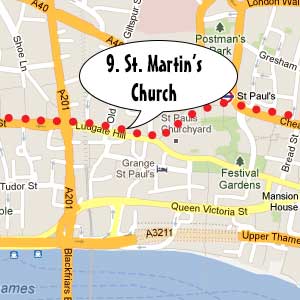
Fleet Street
The conduit here had been freshly painted and a pageant featuring a tower with four turrets had been erected. From each turret a “cardinal virtue” spoke to Anne promising that they would never leave her and that they would aid and comfort her. There were also instruments making a “heavenly noise” and the conduit ran red wine and claret all afternoon.
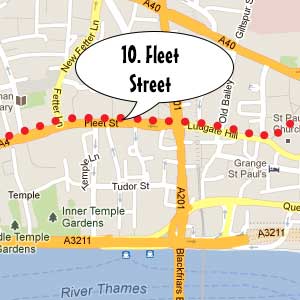
Temple Bar (the last recorded pageant)
Temple Bar had been newly painted and here there was a choir of men and children signing to the Queen.
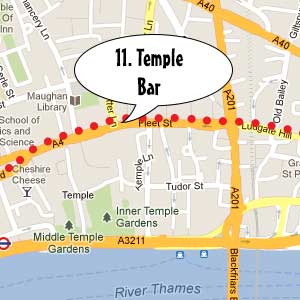
“The noble tryumphaunt coronacyon of quene Anne” pamphlet records that Anne then made her way via Charing Cross to Westminster Hall, which was described by Hall as newly glazed and decorated with “cloth of arras”. There, Anne enjoyed refreshments such as “spice plates”, hippocras and wine, which she shared with her ladies. She then gave thanks to lords, ladies and Mayor, and retired for the night. Both Hall and the pamphlet record that Anne was then taken secretly to spend the night with the King at his “Manor of Westminster”. She must have been exhausted after the procession, but she still had a big day ahead of her.
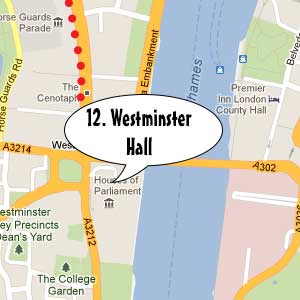
Nicholas Udall and John Leland were asked to write poetry for the various pageants which made up Anne Boleyn’s coronation procession and you can read them at http://www.philological.bham.ac.uk/boleyn/contents.html – click on “translation” to read them in English.
You can read more about Anne Boleyn’s coronation procession and its route in Nasim’s article – click here.
Roland Hui has done a beautifully illuminated Anne Boleyn coronation book using the text of “The noble tryumphaunt coronacyon of Quene Anne, wyfe unto the most noble kynge Henry VIII”. He used calfskin vellum, with illustrations done in ink with raised and silver gold leaf. You can see photos of it at Photobucket.
Notes and Sources
- “The noble tryumphaunt coronacyon of Quene Anne, wyfe unto the most noble kynge Henry VIII”, printed by Wynkyn de Worde in 1533.
This can be read online at http://archive.org/stream/maneroftryumpheo00goldiala#page/18/mode/2up - Hall, Edward. Hall’s Chronicle, p800-802